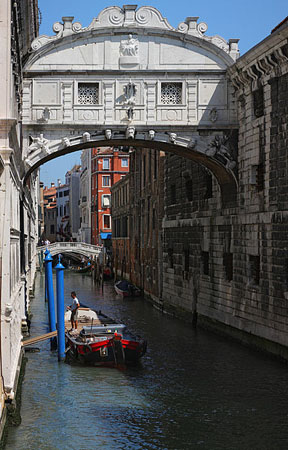 |
| Picture by Mfield, Matthew Field, http://www.photography..mattfield.com |
Older, historic bridges are generally smaller and more decorated than their simpler but functional modern counterparts. However they can provide lots of opportunities as a consequence of their ageing nature, more ornate details and intricate designs. Look for features such as eroded and stained stone carvings, or flights of old steps, which may make a wonderful focus for a photographic composition. Where possible, try to find a frame, or partial frame, through which the bridge can be viewed. This introduces depth and helps to show the bridge in the context of its surroundings.
The image on the right shows the Bridge of Sighs in Venice which is only a few metres in length. It links the interrogation rooms in the Doge's Palace to the cells in which prisoners awaiting trial were once held. When examined closely, the structure reveals all sorts of intricate designs in the stone work as well as carvings and of course the famous grilled windows that gave the bridge its name.
As with almost all photography, the softer light of early morning and late afternoon highlights texture and add warmth to images. However, rewarding images can also be created in the middle of a bright day when the light is overhead and the contrast may be high. The image of the Bridge of Sighs shows an example of this. The walls on either side of the bridge more or less block direct sunlight except for a short period in the middle of the day. The detail of the stonework is highlighted by the overhead Sun and the rays have penetrated to the boat in the foreground.
The angle at which a bridge is viewed often has a powerful effect on an image. An angle of view at right-angles to the direction of the bridge, giving a flat side view, is not usually the best option. Try walking along the banks at either end of the illuminated side of the structure to see how the perspective changes. In the case of the Bridge of Sighs, this was obviously not possible.
Contrast is often a problem when photographing bridges in strong daylight. The shadowy arches beneath a solid structure can be very dark and light reflected from the illuminated structure much brighter. A meter reading taken from the illuminated areas will leave the arches under-exposed to the extent that detail is lost. One solution is to take two images, each exposed correctly for the light or dark areas, and then use high dynamic range (HDR) techniques to combine them.






